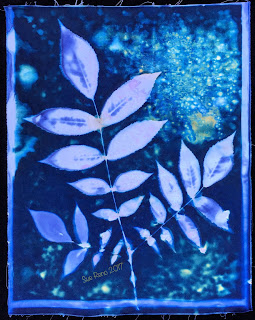I also experimented with spraying just a bit of strongly diluted washing soda water around the perimeter of the prints, just before adding the glass cover, with the intention of breaking down the chemistry to get more colorization.
I found a volunteer sumac shrub sprouting in one of my flower beds, and put the pruned shoots to good use.
I worked with sumac years ago, in a heliographic paint print that I made into an autumnal colored quilt:
 |
| Sumac by Sue Reno |
Here are the prints after about 24 hours exposure, with daytime temps in the 80s F, moderate humidity, and intermittent sun. After removing the glass the plant material, I set them aside to dry completely before rinsing. The marks on the plume poppy leaf were looking encouraging.
The calla lily print was not at all encouraging. Despite being exposed on a presumably flat surface, the leaf structure captured the moisture under the glass and funneled it to the leaf tip, where it washed out all the chemicals in a big white blob.
Both sumac prints were looking good.
As was the cypress; it seemed to have some added marks from the evergreen sap.
Here are the rinsed, dried, and ironed finished prints. I'm very, very happy with the plume poppy. (All images enlarge when clicked.)
I am always happy to experiment and learn, so I can take the failure of this calla leaf print in stride. And few things are irredeemable, so I could add definition with paint and/or stitch and make something out of this. But realistically, I'd rather spend my time with a print that excites me, so this one will probably go in the cutter pile. It will be valuable for adding the right colors and contrasts to patchwork ultimately surrounding other prints in an art quilt.
Both sumac prints came out well.
I'm happy with the extra mottling the washing soda added.
I'm also happy with the delicacy of the cypress print. I'm not sure how I could best add stitching to it, so that gives me something to ponder.
If you are new here, welcome! After many years of working with traditional cyanotype prints on fabric, I'm having a wonderful summer adventure experimenting with the new-to-me technique of wet cyanotype. I'm documenting everything I'm trying, the successes and the quasi-failures, and the posts can all be accessed in reverse chronological order by clicking on the Wet Cyanotype tab in the top header. You can also follow my adventures on your social media of choice:
Facebook page:http://www.facebook.com/suerenostudio
Twitter feed: http://twitter.com/suereno
Tumblr: http://suerenostudio.tumblr.com
Instagram: https://www.instagram.com/sue_reno_studio/















No comments:
Post a Comment